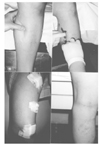New Trend of the Varicose Veins
Article information
J Korean Med Assoc. 2003;46(12):1097-1104
Publication date (electronic) : 2003 December 31
doi :
https://doi.org/10.5124/jkma.2003.46.12.1097
Abstract
Varicose vein is a very common vascular disease. The most common symptom is leg pain. Long-standing jobs, pregnancy, and a positive family history are the major predisposing or precipitating factors. The mainstay of treatments includes compressive stocking, sclerotherapy, stab avulsion and stripping of vein, ligation of saphenofemoral junction, transilluminated powered phlebectomy, VNUS, and endovenous laser treatment.
Keywords: Varicose vein; Sclerotherapy; EVLT
References
2. Michael PG. Sclerotherapy ; Treatment of varicose and telangiectatic leg vein 1995. Second edith ed. San diego: Mosbi-Year book;
3. Cotton LT. Varicose veins ; Gross anatomy and development. Br J Surg 1961. 48589.
5. Eklof B. Surgery or sclerotherapy for varicose veins Adstrumque paratus. The Procedeedings of the Straub Pacific Health Foundations 1993. 5746–47.
7. Cohn MS, Seiger E, Goldman S. Ambulatory phlebectomy, using the tumescent technique for local anesthesia. Dermatol Surg 1995. 21315–318.
8. Cheshire N, Elias SM, Keagy B. Powered phlebectomy in treatment of varicose veins. Ann Vasc Surg 2002. 16488–493.
9. Rautio T, Ohinmaa A, Perala J. Endovenous obliteration versus conventional stripping operation in the treatment of primary varicose vein. J Vasc Surg 2002. 35958–965.
Article information Continued
Copyright © 2003 Korean Medical Association




